Market Dominance Guys
Prospecting and Pipeline
Episodes

Wednesday Aug 13, 2025
EP257: The Laser Pointer Problem: Why Your Reps are Chasing AI Like Distracted Cats
Wednesday Aug 13, 2025
Wednesday Aug 13, 2025
Chris and Corey are joined by Blackpearl Group’s CTO, Sam Daish. In this episode, he's dousing us with the reality of why most sales AI tools are basically expensive cat toys. Blackpearl has built Bebop.AI, a tool that makes sense as an addition to a sales pro’s tech stack. It could probably replace several nonsensical shiny AI tools they are currently batting around instead of making calls.
Corey's firing questions about AI fatigue (because let's face it, we all have it), while Chris goes full mathematician on us with this brutal insight: sales reps are like cats chasing laser pointers with AI. Lots of movement, lots of fascination, but nobody's actually catching anything.
You may wonder how this fits in with BeBop.ai. It will make more sense after you hear the origin story - they almost called it "Hot Pipe" until someone pointed out the, uh, alternative interpretations. Instead, they went with a full bebop jazz vibe in the function and tone because they wanted sales to feel like improvisation, not a pile of dated rigid playbooks.
As the real kicker, Chris breaks down why most AI implementations fail: false negatives. You're not just calling the wrong people - you're missing the right ones entirely. And Sam's nodding along because BebopAI tackles this by making the entire Internet your database instead of some limited proprietary dataset.
The feature that gets reps most excited? Not the fancy prospect data. It's the objection handling. Turns out confidence beats information every time.
Join us for this episode, “The Laser Pointer Problem: Why your reps are chasing AI like distracted cats .”
Action Items Suggested in This Episode:
For Sales Leaders/CROs
Audit your AI strategy focus - Are you trying to bring bottom performers up, or amplify your top performers? Chris argues the latter delivers exponentially better ROI
Identify your "Jonti McLarens" - Find your top performers and give them 10% more time/better tools (equivalent to adding 10 middle-tier reps)
Evaluate your current AI tools - Are they creating "laser pointer cat" behavior or getting reps to more conversations?
For Sales Reps
Test BeBop.ai's's dossier approach, with a special focus on the objection handling feature that receives the most positive feedback.
Use AI for discovery prep, not avoidance - Read dossiers in the minutes before scheduled meetings when memory retention is highest.
Ask "why" to AI responses - Sam emphasizes this helps uncover hallucinations and improves reasoning.
For Sales Operations/Enablement
Shift from proprietary databases to "Internet as database" tools - Evaluate platforms that can digest broader data sources
Implement AI that works as "companion, not a replacement" - Focus on tools that enhance human expertise rather than substitute for it
Measure false negatives, not just false positives - Track opportunities missed, not just wrong prospects contacted
For Product/Marketing Teams
Load your website into BebopAI - Sam says this simple step works really well for basic company understanding
Document your go-to-market messaging - Feed it into AI tools for consistent, company-specific responses.
Create objection handling libraries - The most requested feature, according to Sam's feedback.
For Executives/Investors
Recognize top salespeople as an innovation economy constraint - Chris's thesis: Elite sales performance limits how fast innovation spreads
Budget for commission accelerators - Top performers using AI tools may exceed traditional quota expectations
Rethink headcount-based scaling - Focus on amplifying existing top talent vs. adding middle-tier reps
Immediate Next Steps
Try the "Internet as database" approach - Ask AI tools open-ended questions like "find me customers for [your company]"

Wednesday Mar 12, 2025
EP252: Birdies & Bookings - Taking Cold Calling Out of the Office
Wednesday Mar 12, 2025
Wednesday Mar 12, 2025
Corey Frank and Chris Beall are taking cold-calling to places it's never been before. What happens when you combine the precision of a golf swing with the art of a sales conversation? Our guests Gerry Hill from ConnectAndSell and Josh Smith from CRO Connected decided to find out by creating what might be the world's first golf course cold-calling championship.
Armed with ConnectAndSell's mobile app, headsets, and a film crew, these brave souls tackled both fairways and prospect objections simultaneously, creating what Chris Beall calls 'beautiful lunacy.' Whether you're a sales leader looking for innovative ways to engage your team or just someone who appreciates the hustle of trying something absurdly difficult, this episode showcases what happens when you take your craft seriously enough to have fun with it.
Imagine the gentle rustling of golf course trees in the background, and join Corey and Chris for a conversation about breaking the mundane mold of B2B sales while navigating literal and metaphorical sand traps.
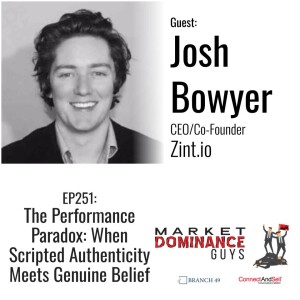
Wednesday Feb 12, 2025
EP251:The Performance Paradox - When Scripted Authenticity Meets Genuine Belief
Wednesday Feb 12, 2025
Wednesday Feb 12, 2025
In today's spontaneous episode of Market Dominance Guys, Chris Beall ambushes (his words, not mine) an extraordinary cold-calling talent: Josh Bowyer, CEO and co-founder of Zint Technology. What unfolds is a masterclass in the art of cold-calling performance, authenticity, and the delicate dance between manufactured delivery and genuine belief.
Josh shares how he's booked over 100 meetings in just 4.5 weeks using ConnectAndSell, but the real gold is in his insights about perfecting his cold call 'performance' over thousands of iterations while maintaining authentic curiosity. As he puts it, the key is simple: 'Just don't sound like a dick in the first 7 seconds.'
From discussing the impact of AI on sales to exploring the critical balance between scripted performance and genuine belief, this conversation reveals why top performers like Josh can consistently convert cold calls into meetings. Chris and Josh dive deep into how the best cold callers combine theatrical precision with sincere conviction that they offer real value.
The episode wraps up with a fascinating discussion about the future of sales in an AI world, including Josh's recent encounter with what he suspects was an AI bot trying to get his insurance renewal date.
Join Chris and Josh for this unplanned but insight-packed exploration of what makes cold calling work at the highest levels.Links from this episode:
Zint.io
ConnectAndSell
Branch 49
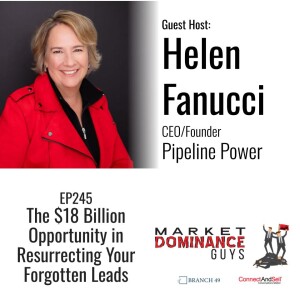
Wednesday Oct 09, 2024
EP245: The $18 Billion Opportunity in Resurrecting Your Forgotten Leads
Wednesday Oct 09, 2024
Wednesday Oct 09, 2024
We're shaking things up today with Helen Fanucci, CEO and Founder of Pipeline Power, taking the reins as our host. Helen engages Chris Beall in a thought-provoking exploration of dormant leads - those overlooked opportunities that could be gold mines for your business. Chris reveals a startling statistic: "91% of $18 billion is wasted" on leads that never get a conversation. This episode uncovers how this massive waste could be your next big opportunity. Helen and Chris dissect the challenges of following up on inbound leads and discuss innovative strategies to breathe life into these sleeping giants of sales potential.
Some of the key points covered in part 1 of this conversation include:
Definition and origin of dormant leads
Statistics on conversation coverage for inbound leads
Importance of quick response times to inbound leads
Comparison of web form submissions vs. inbound phone calls
Introduction to ConnectAndSell's Instant Response and Lead Injection features

Wednesday Aug 21, 2024
EP238: The Innovator's Guide to Building a Foolproof Selling Machine
Wednesday Aug 21, 2024
Wednesday Aug 21, 2024
In this unique episode of Market Dominance Guys, Chris Beall flies solo to unveil the blueprint for a revolutionary concept: the selling machine. As innovation accelerates and markets expand globally, Chris argues that a systematic approach to sales is not just beneficial—it's essential. He outlines a framework that transforms the traditional go-to-market strategy, making it more efficient, scalable, and cost-effective. Hat tip to Branch 49 and Corey Frank's team. This episode is a goldmine for innovators, startup founders, and sales leaders looking to bridge the gap between groundbreaking ideas and market success. Chris breaks down the components of a selling machine, from crafting the perfect offer to scaling operations, all while emphasizing the human elements that drive results. Join Chris for this episode, "The Innovator's Guide to Building a Foolproof Selling Machine."
Here's a unique gift from this episode - an outline of Chris' plan for building a sales machine. You'll have to listen to the full episode to get the details, but this gives you a way to follow along:
Define the offer:
Draw a circle with an arrow pointing right
Identify the beneficiary (stick figure)
Determine the unit of value delivered
Estimate the monetary value for the beneficiary
Identify the "flying car" (hard part) of the innovation:
Use AI or other resources to find a solution
Build a simple version to solve the core problem
Address potential objections:
Anticipate why conservative buyers might reject the offer
Prepare answers to these objections
Identify and describe all dependencies - more lines in the circle
Generate a usable list of potential customers:
Use available data to create a hypothetical list
Sort by title and remove obvious false positives
Choose a calibrated conversationalist:
Use a service like Branch 49 if needed
Test the message:
Aim for a 5% conversion rate on cold calls
Modify the message if necessary
Conduct discovery meetings:
Close these into reference customers
Offer additional support to early adopters
Scale the selling machine:
Start with one conversationalist, then add a second
Continue scaling to groups of eight with proper management
Implement follow-up systems:
Call those who don't attend scheduled meetings
Set up quarterly follow-ups for those not initially interested
Refine and segment lists based on interactions
Involve subject matter experts (SMEs):
Bring in founders or other experts after successful discovery meetings
Generate more subject matter experts as needed
Develop materials to transmit expertise without constant human involvement
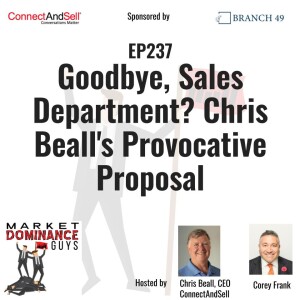
Wednesday Aug 14, 2024
EP237 Goodbye, Sales Dept.? Chris Beall's Provocative Proposal
Wednesday Aug 14, 2024
Wednesday Aug 14, 2024
In this episode, Chris Beall poses a provocative question that challenges the very structure of sales departments. What if companies didn't need traditional in-house sales teams at all?
Sounds radical, right? But Chris takes us on a thoughtful journey through the potential of outsourced sales. From list building to discovery calls, he explores how specialist expertise could revolutionize each step of the process.
Using his experience at ConnectAndSell and citing innovative approaches from companies like Branch 49, Chris makes a case for keeping only subject matter experts in-house. He backs his ideas with real-world examples and data, showing how modern technology enables this shift.
This episode might just transform how you think about sales team structure and efficiency in the modern business landscape. Join us for this episode, "Goodbye, Sales Department? Chris Beall's Provocative Proposal."
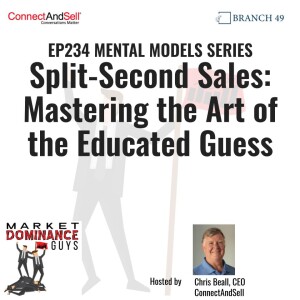
Wednesday Jul 17, 2024
EP234: Split-Second Sales: Mastering the Art of the Educated Guess.
Wednesday Jul 17, 2024
Wednesday Jul 17, 2024
In this episode of our Mental Models series, Chris kicks off by comparing sales processes to a manufacturing line, where quality at each step is crucial. But he quickly switches to a meatier topic: the role of "the guesser" in business decision-making. "Time is never our friend," Chris warns as he unpacks why every organization needs a designated decision-maker for those moments when the clock's ticking and information is scarce. He dives into the challenges of this role, from avoiding its use as a "political weapon" to ensuring the guesser has the trust and authority to act. Chris even draws parallels to a batter facing a pitch in the majors, illustrating the split-second nature of these decisions. Whether you're a sales leader or a professional navigating uncertain terrain, Chris's insights on decisive action in the face of uncertainty offer a fresh perspective on leadership and strategy in this episode, “Split-Second Sales: Mastering the Art of the Educated Guess.”
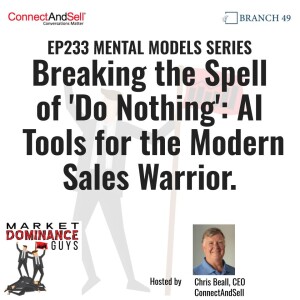
Tuesday Jul 09, 2024
EP233: Breaking the Spell of 'Do Nothing': AI Tools for the Modern Sales Warrior
Tuesday Jul 09, 2024
Tuesday Jul 09, 2024
In this next episode of our Mental Models series, Chris tackles two critical aspects of modern sales strategy. He begins by examining the 'do nothing' competitor - often your most formidable adversary. Chris uses vivid analogies to illustrate why prospects cling to the status quo, invoking the familiar and ominous warning that 'Winter is Coming.' He then explains how to position your solution as a complementary, hybrid approach rather than a disruptive replacement.
Chris then explores how AI tools, particularly ChatGPT, revolutionize sales operations. He shares practical, step-by-step techniques for using AI to expand your target lists, refine your sales scripts, and challenge your existing mental models. Drawing from his daily use of ChatGPT, Chris offers insights on staying ahead of the curve and avoiding mental ruts.
Throughout the episode, Chris examines the balance between embracing new technologies and respecting established business practices, all while focusing on improving your sales effectiveness in an ever-evolving market landscape. Join him for this episode, "Breaking the Spell of 'Do Nothing': AI Tools for the Modern Sales Warrior."
Links from this episode:
RightBound
5 Sentences That Will Change Your Life
Corey Frank on LinkedInBranch49Chris Beall on LinkedInConnectAndSell
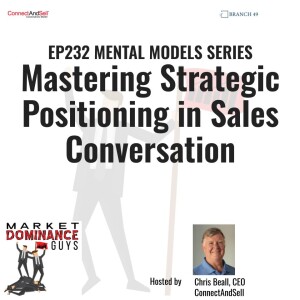
Tuesday Jul 02, 2024
EP232: Mental Models - Mastering Strategic Positioning in Sales Conversations
Tuesday Jul 02, 2024
Tuesday Jul 02, 2024
In this episode of our Mental Models series, Chris dives into the crucial topic of strategic positioning and the competitive landscape. Chris dissects how to effectively align team mental models, using ConnectAndSell as a real-world example. He explores the concept of positioning against alternatives, emphasizing the importance of complementary strategies and differentiating based on customer mission achievement. This episode offers valuable insights for businesses looking to refine their market approach in an increasingly competitive landscape.

Wednesday Jun 12, 2024
EP230: Michelangelo's Market Dominance Secret to Sculpting Your List
Wednesday Jun 12, 2024
Wednesday Jun 12, 2024
Are you ready to sculpt your way to market dominance? In this episode, Chris Beall embarks on a solo journey to explore the art of crafting your perfect target list. He's also apologizing to you for glossing over this essential aspect of your sales strategy, and now he's determined to make things right. Just like Michelangelo's David, your ideal market is hidden within a huge block of data, waiting to be unveiled. But unlike marble, this data is more like clay - you can always add a bit back if you trim off too much. Chris will be your guide as you shape and mold your list, navigating the tricky landscape of false positives and negatives and using conversations as your tools to refine your market-dominating masterpiece. So, roll up your sleeves and get ready to get your hands dirty - it's time to uncover your own David (and no, we're not talking about the statue's abs). Join us for this episode, “Michelangelo's Market Dominance Secret for Sculpting Your List."
Links from this episode:
Corey Frank on LinkedInBranch49Chris Beall on LinkedInConnectAndSell
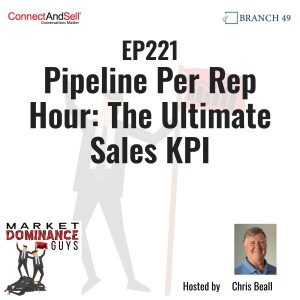
Tuesday Apr 09, 2024
EP221 - Pipeline Per Rep Hour: The Ultimate Sales KPI
Tuesday Apr 09, 2024
Tuesday Apr 09, 2024
In this solo episode of Market Dominance Guys, Chris Beall unveils the ultimate sales KPI: pipeline dollars generated per rep hour. This metric is a game-changer for CROs, CFOs, and CEOs looking to optimize their sales efforts and drive business growth. Chris explores the importance of measuring and maximizing this KPI, sharing insights from ConnectAndSell's own data and revealing the significant potential of a well-executed market dominance program. He breaks down the different types of attribution, ideal conversation and meeting rates, and optimal prospecting hours per week. Whether you're a sales leader aiming to improve your team's performance or a C-suite executive seeking to understand the economics of your sales efforts, this episode will help you discover how pipeline per rep hour can help you take your company's revenue generation to new heights.
FULL EPISODE TRANSCRIPT Below:
[00:00:00] Chris Beall: Hey everybody, Chris Beall with Market Dominance Guys with an episode about a bunch of numbers, a bunch of KPIs. And I decided since it's just going to be numbers I'd leave Corey to do something more useful than ask me questions about numbers.
[00:00:16] Chris Beall: So, I came up with the questions myself and [00:00:20] I'll play you with them. It's right now, the 4th of April, 2024, right before Tax Day. And I was speaking last week, had the pleasure of speaking with Mike McCracken, the Founder and CEO of McCracken Alliance Partners, who provide all the information. amazing help with regard [00:00:40] to finance things, not just taxes, which is that'd be fairly straightforward, probably, although they can be complex, but really how to make your company sing, how to make your company dominate even with the help of financial professionals who know what they're talking about and who will work with you to make [00:01:00] some stuff happen that you probably didn't believe could happen.
[00:01:03] Chris Beall: So I asked Mike a question. I said, Hey, Mike it kind of bothers me that ConnectAndSell, which primarily has two impacts on companies that one would think CFOs would be interested in. One is immediate increase in pipeline, and everybody [00:01:20] knows that pipeline is a leading indicator of future revenue, and CFOs sure like to be able to forecast future revenue with
[00:01:27] Chris Beall: greater accuracy, specificity, and fidelity. And then it also allows you to decrease costs immediately because you can do more with less. And [00:01:40] less tends to be unnecessary headcount, extra headcount. You can also do more with more if you're in the mood to do that. But in any case, there's an efficiency play and capital efficiency is of great interest to CFOs.
[00:01:51] Chris Beall: And Mike, he gave me a great answer. He just like, boom, hit me between the eyes. He said, Chris, you gotta come up with a KPI that [00:02:00] is meaningful to CFOs, that's meaningful to the business. And I said, well, we have one of those, and it's called Pipeline Built Per Rep Hour. And I thought, as I was out doing my little barefoot trot today, getting the usual comments from folks, what is it about going barefoot that makes everybody think that you're weird?
[00:02:19] Chris Beall: I [00:02:20] don't know. In any case, I was out there trotting along in beautiful Arizona sunshine, and thinking, why don't I just say what some really good values would be for some, KPIs, some metrics that folks tend not to think about very much. And so I, I just thought I'd share [00:02:40] some we measure at ConnectAndSell what we call attribution, and we measure three kinds.
[00:02:47] Chris Beall: So one kind is what we call direct attribution. That's looking at all the pipeline that's been built directly from meetings, appointments that were set in, ConnectAndSell. We know that happened because there are [00:03:00] dispositions that indicate that a meeting was set and there. Certainly is pipeline out there to be measured, and you can link it together a number of different ways.
[00:03:09] Chris Beall: The most straightforward is by the account name, by the customer name, and you can say, hey, set a meeting with somebody. Pipeline shows up later. How much pipeline? [00:03:20] What stage is it in? And you get a pretty good read on what you're prospecting is accomplishing in terms of dollars of pipeline. That are being set by your reps, but what's in the denominator and the big question that I think really is out there for all of us who care about prospecting and anybody who doesn't care about [00:03:40] prospecting, certainly they either got some other weird kind of magic going on.
[00:03:45] Chris Beall: Or and bless you if you do, right? You don't need prospecting, you're in a special place. But most businesses need prospecting. And, in fact, Jason Lemkin just wrote an article this week talking [00:04:00] about how the new KPI for venture finance companies, not just net retained revenue, not even just gross retained revenue, all the stuff that's about, oh my God, what if we lose a customer?
[00:04:13] Chris Beall: We got to keep them all very conservative sort of way of looking at the world. It's about your [00:04:20] ability to add new customers. Well, add new customers is what prospecting is all about quite frankly. So now we have tied prospecting to the new, most important KPI that venture capitalists care about, which is adding new customers.
[00:04:37] Chris Beall: It actually made me go take a look and I [00:04:40] was pretty happy with what I saw for our company. It was interesting to see, a little bit more than a hundred percent new customers added over the last year. Some of which have come through partners who are working on an appointment setting basis, and they're doing things for companies that would rather have somebody else do it, most of which are [00:05:00] customers of ours that are having ConnectAndSell help them do prospecting so they can get new customers and get new pipeline in a reasonably efficient way with predictability, visibility, and control.
[00:05:13] Chris Beall: So that's really interesting. Pipeline is the number that we tend to look at. [00:05:20] And new customers are a, another number. I'll call those numerators. But what should we be looking for in the denominator? Well, I'll go to pipeline right now. We measure something called pipeline per rep hour. And we measure it, as I said, one way, which is what we [00:05:40] call direct attribution.
[00:05:42] Chris Beall: That means came from meetings. We measured it another way, which is came after positive conversations. Positive conversations are like, I'm interested, send me information, that sort of thing. And then, there's the pipeline that comes from any old conversation. So any old conversation could be a negative [00:06:00] conversation, could be a blow off.
[00:06:02] Chris Beall: The fact of the world is, when you talk to somebody, they're more inclined to take a look at your website. And they're much more inclined to answer that email that you wisely sent them that says thank you for our conversation today and also much, much, much more inclined to actually speak with you if you call them in the future [00:06:20] because you've already demonstrated that they answer the phone.
[00:06:23] Chris Beall: And it's more likely to be a good conversation because you've had a conversation, however brief, and you can open the next conversation effortlessly with what you wanted to say, but kind of didn't get to say. How to, start that next conversation is something you make [00:06:40] available to your future self and in a set it and forget it kind of way, you become a sales genius.
[00:06:46] Chris Beall: But what's in the denominator? Okay. So there's pipeline measured three ways. In the denominator. must be, it seems to me, the number of hours that reps spend prospecting. Now, I venture to [00:07:00] say most of us have no idea how many hours our reps spend prospecting. And one of the, I think, appeals of the SDR BDR revolution is, hey, I've got reps that are just prospecting, so I can allocate all of their hours, I can tag all of their hours, categories, categorize all of their hours [00:07:20] as prospecting hours.
[00:07:22] Chris Beall: I don't know if this is true or not, but I am sure that when somebody's in a ConnectAndSell session and they've pushed the button, as we say, and they're having conversations, that we have verifiable time spent prospecting. And that's a cost to the business. Those reps cost money. [00:07:40] They're fully burdened rate is whatever it happens to be that can be burdened with just the usual, but you could also throw in all the tools and technologies and data and all that kind of good stuff you have to provide and you can get an idea of what a rep costs you per hour.
[00:07:56] Chris Beall: You can, if you know how much pipeline was built by that [00:08:00] rep, by each rep, in each hour, and you know it in all relevant ways, one way would be directly through meeting set, that's the one that most folks will measure, if they measure anything, by the way. Another one is positive conversations that lead to pipeline.
[00:08:15] Chris Beall: And another one is the really the good one, this you probably [00:08:20] won't believe, but it is the best KPI. Is. Pipeline built per hour from any conversation. You don't know what really has happened. A lot of stuff kind of goes out into, I'll call it sort of the action cloud. That is what's going on out there when someone has been spoken with by [00:08:40] one of your reps.
[00:08:41] Chris Beall: You don't know. They can, that person, that target. They could talk to somebody else. They could go to your website. They could have a thought about what it is you do. They could check out you and your competitors, which is not a bad thing, by the way, if they haven't been thinking about a solution in your space.
[00:08:56] Chris Beall: They certainly can answer an email or at least [00:09:00] read an email that you send them. So there's a lot of things that can happen. You can advertise to them. A lot of things can happen after a conversation. But the pipeline is pretty easy to measure. It comes right out of your CRM. Opportunities are there.
[00:09:11] Chris Beall: They're in stages. Therefore different accounts, and you know that you talked to somebody at that account. Certainty is not the goal here. You can get [00:09:20] a perfectly good KPI without certainty. And, like all good data, you can measure it over time. You can trend it. And then you can go and correlate it to the final results, which is
[00:09:32] Chris Beall: ultimately bookings and then revenue and if you're a kind of an ARR or MRR kind of company ARR and MRR [00:09:40] because those could be interesting too. So number one new KPI to pay attention to pipeline generated per rep hour, and I'll give you some numbers that will sound different from what you might expect. I'm looking at the last year.
[00:09:57] Chris Beall: So today is I'm [00:10:00] treating it as the end of March, so sort of April of last year, which is 2023 to end of March 2024. And I'm looking at a fair number of companies, about 130 of them, that I have pipeline per rep hour measured for. So, a really good number, [00:10:20] a fantastic number, is also a really big number.
[00:10:24] Chris Beall: Some of these you kind of look at and you go, well maybe they're a little early in the game, but some of them are pretty stunning in any case. So one of our customers, for instance, and I won't say their name because they haven't authorized me to do that. They sell deals in an [00:10:40] average of about $73,894. And the pipeline that they're building per rep hour in the last year is $378,082 of pipeline per rep hour of prospecting.
[00:10:57] Chris Beall: Now, darn well they're not paying any [00:11:00] of their reps. $378,000 an hour. Do we know what their gross margin is? So we'd actually be able to say how much money is coming in, do we think, from these deals. Do we know what the probability of the deals are? Do we know when the deals are going to close?
[00:11:14] Chris Beall: Yes, we actually do know all those things, and those are very interesting to break down. But the [00:11:20] first thing to know is , you got to generate pipeline across all the different stages with a lot of different cycle times when they're actually anticipated to close, a lot of different probabilities in order to have business.
[00:11:34] Chris Beall: That's just the way it is. So this is $378,082 an hour. The [00:11:40] next one down is a very large company that is pretty fascinating, actually, if you kind of looked at what they do. But their deal sizes are really big, like $2.77 million per deal. And they're generating $265,047 of pipeline per rep hour. And now I'm going with the pipeline that [00:12:00] is from all conversations, not merely that came directly through meetings, although we could look at that, but this is, I believe, the true most important KPI to pay attention to.
[00:12:12] Chris Beall: So next is $258,586 of pipeline per rep hour, [00:12:20] $164,766. So let's go down a ways. I'm going to get to a company that is at about number 30 on the list. So actually, I'll go with our company, ConnectAndSell. How much pipeline do we generate per rep hour? So, our average deal [00:12:40] size is not huge. We do initial deals that are in the sort of $20,000 range.
[00:12:45] Chris Beall: There's, some of them can be very large, some can be smaller, but we like to get started with folks in a way that really makes sense for their business. And we do a lot of prospecting. How much prospecting in that last year? A lot of prospecting. [00:13:00] 13, 578 hours of prospecting. That's a fair amount to generate a fair amount of pipeline.
[00:13:10] Chris Beall: So when you look at it, that's 132 million dollars of pipeline. So it's $9,731 per rep. hour [00:13:20] of prospecting that can be measured. This is not taking all of the hours in the day for these reps. This is the hours they're spending. in sessions where they're pushing button, talking to a target, and then wrapping up, we call it, which is taking notes, setting the, that little teleprompter for their future self and [00:13:40] setting a disposition.
[00:13:40] Chris Beall: So, and we're gaining intelligence as a company about all of these conversations and also separating out and segmenting the market into folks who answer the phone, we know answer the phone because we spoke with them and folks who haven't answered the phone yet. Across all of those, of course I don't, know why we wouldn't do [00:14:00] this.
[00:14:00] Chris Beall: We measure their tendency to answer the phone across the entire community. We crowdsource that tendency to answer the phone and keep that current every day. Not for everybody, but for about 24 million folks that are worth talking to. We call it fast phone numbers. So all that intelligence is coming back.
[00:14:17] Chris Beall: But the other thing that's coming back is [00:14:20] opportunities going into the CRM and those opportunities have dollar amounts associated with them. They also have probabilities and stages and all that kind of good stuff. But right now I'm talking about the most important KPI that's probably new to you. And if you're measuring this KPI already, pipeline [00:14:40] dollars per rep hour, I'm super impressed, unless you're already a ConnectAndSell customer, in which case we're measuring it for you.
[00:14:47] Chris Beall: And then you're getting to understand it and break it down. We break it down for you, trend it, see how it's associated with individual reps. Would you like to know that each rep that is doing prospecting [00:15:00] is generating pipeline, and how much? Because being able to do attribution to marketing spend is one thing, but being able to do attribution to what you're spending on the actual folks that are out prospecting, that's whether they're SDRs and BDRs, or whether they're account executives, in our case, it is a mix.
[00:15:18] Chris Beall: Everybody at ConnectAndSell [00:15:20] prospects. Big surprise, right? So when you look at all of your numbers and you think about your business, whether you're a CEO, whether you're a CFO, whether you're a CRO, whether you're a business development manager, a BDM, a SDR manager, a sales manager, a VP of sales, whatever you are, [00:15:40] this KPI is the KPI you should be paying immediate attention to. Now, once pipeline per rep hour, you've kind of simplified this production of pipeline, which is you either add more rep hours or you improve the pipeline [00:16:00] being set per rep hour by improving either the number of conversations and impact of those conversations. So conversations per hour, is important.
[00:16:10] Chris Beall: Now we're going to go to the other end of the spectrum. What are the drivers, right? So the simple drivers are conversations per hour. Have more. What's a [00:16:20] reasonable number of conversations per hour that makes sense to have? There's a number somewhere between six and say 12 really can make a difference.
[00:16:31] Chris Beall: Our average over all of our customers last year is about 9. 4, but it's highly varied because they're using different [00:16:40] protocols. Some are connecting on live voice, some are connecting only when the target answers. But if you've got five conversations an hour going on with your reps, you're probably doing pretty well.
[00:16:50] Chris Beall: Now they're probably setting meetings. That's direct attribution. How many meetings per hour is a good number. About half a meeting per hour is a great target. If you're setting [00:17:00] half a meeting per hour per rep, you're probably doing quite well. How many rep hours per week really depends on what your reps are doing.
[00:17:08] Chris Beall: If they're SDRs, my view is they should be doing as many as they can manage. That number is probably about five or six a day. And I know it [00:17:20] sounds like it's terrible talking to people for five or six hours a day. It's actually pretty fun. As long as you don't have to dial, navigate phone systems and do all that kind of junk.
[00:17:29] Chris Beall: So that's that's a number that is interesting in the SDR world. Not many people achieve that. Our reps at ConnectAndSell, they run at [00:17:40] about 5. 8 hours of prospecting per week if they are SDRs. And they run at about 2. 5 hours of prospecting per week if they are account executives. So you can see it varies.
[00:17:54] Chris Beall: The AEs are busy doing other things, but they find time to prospect. They tend to prospect together, by the [00:18:00] way. Together in time, not in space. They're all over the place because it's more fun. And because management then can talk about what we're trying to do in this particular session and we can gain more insights than just the data might give us.
[00:18:15] Chris Beall: So this is about is it, this is a tough one, but I [00:18:20] would say for an AE two and a half hours a week prospecting, real prospecting measurable, probably get the job done. And for an SDR if you really want to dominate, you're probably talking about five and a half hours a week. Then you've got, okay, all this prospecting, prospecting is going on.
[00:18:38] Chris Beall: Have we got the conversations [00:18:40] per week that are, or per hour that are happening? So we now know maybe 60 conversations a week on average, but again, very different between SDRs and account executives. And the same thing with dials that should be done for them. No rep should ever have to do a dial.
[00:18:58] Chris Beall: It makes no sense [00:19:00] whatsoever. Reps should push buttons and talk to people, or hey, if you can talk to people without pushing buttons, that makes sense too. So what do your conversion numbers need to be in order to make this happen? Well, there are two kinds of conversion numbers, cold and follow up. Cold should be North of 5 percent if you're in a market [00:19:20] dominance program, but the main reason you're talking to folks is to segment the market into people you can talk to.
[00:19:25] Chris Beall: Those who answer the phone and people you need to kind of go after a different way. Those who don't answer the phone. For those who answer the phone on the first conversation, what we call a cold call, you're going to be shooting for around 5 percent across all [00:19:40] of your reps. If you have a rep languishing at 2%, or then you have a skill issue.
[00:19:45] Chris Beall: If you have all of your reps languishing at 2 or 3%, you probably have a targeting issue. The issue is that either your target market is being chosen incorrectly, or more likely, your scripting is allowing that easy [00:20:00] exit where somebody just says, "Thanks, we're all set." Almost every cold call script has got a major flaw in it that is going to drive your conversion for cold calls way, way down.
[00:20:11] Chris Beall: Now, not to worry, even if your conversion for cold calls is way, way down, the money is actually in the follow ups anyway. So as long as you're having enough conversation, say a [00:20:20] rep is having something on the order of 50 or 60 conversations with targets per week. That should be generating something on the order of 40 to 50 follow ups.
[00:20:31] Chris Beall: Follow up opportunities. That's people we know answer the phone that you can talk to next week or more likely next quarter. And you can nurture through the 11 [00:20:40] quarters in the future it's going to take for their company to finally want to do business with anybody. And that could include you because you've got the inside track.
[00:20:48] Chris Beall: So you've got a kind of a two distributions called bimodal around the conversion rate. So the conversion rate can be at 5 percent for cold calls and should be at north of [00:21:00] 10 percent for follow up calls. And that also will, interestingly enough, follow up calls reduce the conversations per week just a little bit, because they tend to be longer conversations, but everything kind of comes out in the wash.
[00:21:14] Chris Beall: So, how many conversations should you get, by the way, per dial that's executed for you? Highly [00:21:20] variable, but the cold call world, about 5%. And in the follow up world, something around 12 or 13%. And then, when you kind of look at it overall, you've got dials going on, how many meetings should you have per dial.
[00:21:32] Chris Beall: I don't think this is a particularly compelling, KPI, unless your reps are doing the [00:21:40] dials, but it's kind of good to know. So a number of about 0. 6 percent is a decent number for meetings per dial. And after that, what are the drivers? So let's figure out how can we make the number that we want go up?
[00:21:55] Chris Beall: Well, you can make your average deal size go up, but your market probably determines [00:22:00] that. So I don't think you should push on that one, but that's that one can be interesting. Mostly the big correlation, interestingly enough, and obviously Well, pipeline per rep hour, let's just increase the number of rep hours and we increase the pipeline.
[00:22:18] Chris Beall: It seems too simple, [00:22:20] but it actually is the key to everything. The number one correlation between any of these KPIs and the number of dollars a pipeline produced per day or per week, or per month, whatever it is that you care about, it's actually primarily driven by [00:22:40] simply prospecting time. And a little bit of prospecting time goes a long way.
[00:22:45] Chris Beall: If your pipeline per rep hour is big $100,000 or even $10,000, just add more hours to get more pipeline. But what if I want to get my pipeline per hour up also, not just [00:23:00] add more hours, but add more pipeline? What do I do? Number one thing to do is increase the percentage of follow up calls, follow up pipeline generating prospecting calls compared to cold calls.
[00:23:14] Chris Beall: For some reason, folks get obsessed with cold calling, which they don't even like to do. And it's [00:23:20] like, well, we talked to this person, talked to this person. It's almost like scratching lottery tickets and hoping to get lucky and hope might be a strategy in the world of lottery tickets, not a great strategy in the world.
[00:23:31] Chris Beall: of Market Dominance. So what do you want to do? Well, you want to make sure that your reps are talking to people it [00:23:40] makes sense to talk to, and your follow up lists automatically are full of those people because they either expressed enough interest or your rep decided it was worth talking to them in the future, and they're easier to get a hold of.
[00:23:53] Chris Beall: So that's number one. Number two is fix your messaging so it resonates. Your [00:24:00] messaging probably is driving folks away because it contains too much value. And the value statements in your messaging, we do X and Y for companies like you, blah, blah, blah, are causing somebody to get to achieve their goal in the call.
[00:24:16] Chris Beall: Which is to get off this call with our self image intact by [00:24:20] simply saying, "Thanks, we're all set." So that's the next thing you should do. Why should you do that before you change your targeting, your actual lists? For a simple reason. Until you, you really get there and get to a point where you're confident that at least you don't have a structural, psychological issue in your messaging, [00:24:40] then until you get there, you don't really know how well it's working for targeting.
[00:24:45] Chris Beall: That is, you can't really tell what's resonating. You can get lucky sometimes. But you've got to have what we call a calibrated message. Then you need to get at least one of your reps to the point when, where when they deliver the message it is, consistent. You're going to get [00:25:00] consistent read. That comes back in the form of meeting set per rep hour.
[00:25:06] Chris Beall: So that's, a good one. It also actually comes back in conversion rate, meeting set per conversation. So you need to get to the point where, yes, we know what that, that is, what the conversion rate is, and how it ties to the reps [00:25:20] time. Then we're free to say, okay, now, what part of our list is this working well for?
[00:25:26] Chris Beall: And what part of the list is it not working well for? And you can do segmentation that is more fine grained than what you have today. This is actually a little bit tricky to do, but if you take the [00:25:40] folks that you're setting meetings with, then you take them off to a company like Rev, at GetRev. ai.
[00:25:46] Chris Beall: Fred Mondragon was on one of those. Market Dominance Guys talking about this. You can have them point to a whole bunch of companies that are in this exographics way, in a significant way, similar to the ones that you're setting appointments with. That is, [00:26:00] you don't have to even wait until you've got a whole bunch of business.
[00:26:03] Chris Beall: You're brand new, you're going after a new market. What's the first signal that says that you're going to have pipeline built? It's meetings set. So go and use that. You can also look at the pipeline that's being [00:26:20] set in the CRM based on the conversations. That's the, we call that the possible attribution.
[00:26:26] Chris Beall: So you have two very nice signals that you can use in order to improve your targeting. Once you've done all of that, then it makes sense to actually increase the amount of prospecting time. Until you've got it all calibrated, if you [00:26:40] just increase the prospecting time, you just irritate yourself and people.
[00:26:43] Chris Beall: And you actually, you can burn out a team and you can burn through lists in ways that don't make a great deal of sense. And you can also trick yourself into thinking that you're seeing things, positive and negative things, that aren't actually there. You got to get to the data to see the reality. So, that's that kind of [00:27:00] wraps it up.
[00:27:00] Chris Beall: That's a whole bunch of numbers, but I'm going to come back to the main one. Pipeline dollars per rep hour is the KPI that you need to be looking at. And to do that to have that number to hand, you have to have a way of measuring the actual rep hours spent prospecting and [00:27:20] tying that to the pipeline that's sitting in your CRM.
[00:27:23] Chris Beall: Again, it's something we do at ConnectAndSell as a convenience for you. It's just go ahead and hook up your CRM and we'll measure this every single day and break it down all the way to the individual rep, or to the list, or to the team, or whatever it is that you want, and you'll have that [00:27:40] KPI in hand, but without that KPI, it's really, hard, unless pipeline dollars that are being built per rep hour, it's really, hard to figure out the economics of a market dominance program.
[00:27:54] Chris Beall: So for Corey Frank, you got a day off, Corey, and Chris Beall, this [00:28:00] is Market Dominance Guys
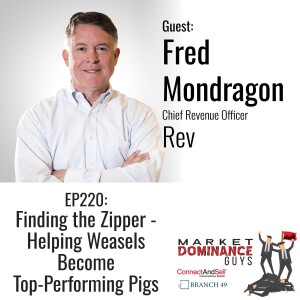
Tuesday Apr 02, 2024
EP220: Finding the zipper - helping weasels become top-performing pigs.
Tuesday Apr 02, 2024
Tuesday Apr 02, 2024
Corey Frank and Chris Beall are once again joined by Fred Mondragon for this final segment from their visit. In the first two episodes with Fred, the guys covered the topic of The Seductive Shadowboxing of CRM data - Fit vs. Intent, Then the other side was discussed - Intent, Fit and the Future of Sales intelligence.
In this final segment, the trio explores how Rev's AI-powered platform is helping sales teams "find the zipper in the weasel suit," transforming weasels into top-performing pigs. Fred explains how Rev's "special purpose AI" leverages vast amounts of data to help reps identify and target their ideal customers, while Chris emphasizes the importance of engaging in trust-building conversations. Corey sees the immense potential in combining Rev's AI targeting with ConnectAndSell's powerful sales acceleration tools to solve the challenge of "Who do I go after next?" Join us for this episode, "Finding the zipper - helping weasels become top-performing pigs."
About Fred Mondragon:
Fred, a senior sales and business development executive with extensive experience at SaaS software companies, joined Rev in 2021. He has managed revenue generation channels at numerous successful startups and large companies, including TimesTen, Oracle, and most recently, Medallia, where he set up the channel sales and alliances function from scratch. Fred received his B.A. and MBA from Stanford.
Links from this episode:
Fred Mondragon | LinkedIn
The Sales Development Platform: Find your next best customer | GetRev.AI
Corey Frank on LinkedInBranch49Chris Beall on LinkedInConnectAndSell
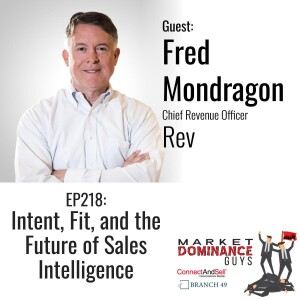
Wednesday Mar 20, 2024
EP218: Intent, Fit, and the Future of Sales Intelligence
Wednesday Mar 20, 2024
Wednesday Mar 20, 2024
Welcome back to the second part of our insightful conversation with Fred Mondragon, where we continue to explore the intricate world of sales intelligence. In our previous episode, the guys discussed the significance of prioritizing fit over intent when targeting potential customers. However, the most successful sales strategies understand that fit and intent must work hand in hand to achieve outstanding prospecting results.
Intent data has become an indispensable tool for sales teams seeking to identify and engage with prospects actively looking for solutions to their challenges. By analyzing online behavior, intent data offers invaluable insights into a prospect's buying readiness. When combined with a deep understanding of customer fit, sales teams can unlock the full potential of their prospecting efforts.
In this episode, Fred shares his expertise with Chris and Corey on effectively integrating intent data with fit-based targeting to create a powerful, holistic approach to sales. They examine the best practices for leveraging intent signals alongside demographic data, ensuring that you're targeting not only prospects who are ready to buy but also those who are the right fit for your solution. Join Chris, Corey, and Fred as they dive into the fascinating interplay between intent and fit, and discover how this synergy can help you achieve unparalleled success in your sales efforts. Listen to episode 218: Intent, Fit, and the Future of Sales Intelligence."
About Fred Mondragon:
Fred, a senior sales and business development executive with extensive experience at SaaS software companies, joined Rev in 2021. He has managed revenue generation channels at numerous successful startups and large companies, including TimesTen, Oracle, and most recently, Medallia, where he set up the channel sales and alliances function from scratch. Fred received his B.A. and MBA from Stanford.
Links from this episode:
Fred Mondragon | LinkedIn
The Sales Development Platform: Find your next best customer | GetRev.AI
Corey Frank on LinkedInBranch49Chris Beall on LinkedIn

Wednesday Feb 21, 2024
EP215: Sales Artisans: Thriving Alongside Smart Bots
Wednesday Feb 21, 2024
Wednesday Feb 21, 2024
This episode wraps up our conversation with Corey Frank, Chris Beall, and Shane Mahi. Throughout this series, the guys have delved into the profound impact of AI on sales, the evolving role of human expertise, and the transformative potential of AI in reshaping businesses. They muse on the future interplay of AI and the craft of sales. Corey champions niches - and the need to summon specialists. And we, the artisans, must elevate our skills. Chris predicts more earthshaking disruption for software developers than sellers. And Shane sounds warnings that agencies lean heavily on human effort today. Soon enough AI shall permeate their ranks.
Our craft endures turbulent seas, yet we shall reach new fortunes with nimble navigation. Mine your own insights from these philosophic titans who've logged countless hours of bold outreach fueled by devotion to their calling. Stay tuned for part 3, where they unveil actionable guidance to navigate what's next for our noble profession. “EP215: Sales Artisans: Thriving Alongside Smart Bots.”
Here is the full series.
Links from this episode:
Shane Mahi on LinkedIn
MEGA.ai
Corey Frank on LinkedIn
Branch49
Chris Beall on LinkedIn
ConnectAndSell
FULL EPISODE TRANSCRIPT Below:
Corey Frank (00:58:09):
Yeah, it is, it is. I would argue the counter to that, it's not really counter, it's more of a pivot. As we said Chris many times, Russell Brunson, one of his books he wrote, says, the riches are in the niches and I believe there will always be a need for specialists. When you have a specialized software that requires not just a transaction but a relationship when folks care about their brand, you will have a niche. I'm a big believer in Plato or Aristotle, et cetera. The unexamined life is not worth living. And so when a person or a salesperson does this, the whole purpose of Flight School in a lot of ways is when they don't examine their life to find their true self or their excellence of function, they're ignoring their true self. And part of what we do certainly at Branch49, certainly Chris, what you do at Flight School, Shane, what you've taught with a lot of your organizations is that sales is a craft and just like being a writer for the New Yorker, it's a craft.
(00:59:30):
Being a tradesman is a craft and there's a lot of crappy bricklayers out there and there's a lot of artesian bricklayers out there. And so I believe that there will always be a market for those that see that this is a mastercraft Shane. One of the stories that we talk all about here at Branch49 is a guy walks past the construction site and sees five guys laying bricks. Greg Chriss wrote the story many, many times. First guy, what are you doing? He's like, I'm making six bucks an hour. Go to the second guy, what are you doing? He's like, I'm building a wall, goes to the third guy. What are you doing? And he's like, I'm building a cathedral and goes to the fourth guy and say, what are you doing? He's like, I'm saving men's souls. So the last two folks, the people who see I'm building a cathedral or I'm saving men, souls are the ones that you want on your team versus the ones that are building a wall or making six bucks an hour.
(01:00:28):
There's a lot of folks in our profession who will leverageChatGPT to say, “Hey, I'm making five bucks an hour but I'm making 30% margin versus I'm making six bucks an hour and I'm making 5% margin.” So those folks who will see this as an efficiency game without a corresponding increase in the delivery of the service, they're the ones that I think will fall by the wayside. I think there will always be a market for the higher end and part of our purpose at Branch49 is to create these organizations where folks can move out into the world and be truthsayers, be the pinnacle of their communities and their craft. We know that folks don't leave Branch49. We say they graduate from Branch49 and that was part of the intention of starting this with Chris's inspiration and I think we celebrate our fourth year coming up here. Chris, it's crazy. It's been four years already and how many millions of phone calls and I dunno how many hundreds of thousands of meetings, but that's my response to that and part of that is tree hugging certainly to be sure what we are doing? We're going to be the best damn buggy whip people that there are on the face of the earth. Even when there's a sparse number of horses in the city, we're still going to be selling these buggy whips come hell or head water.
Chris Beall (01:02:02):
Well actually I think that one of the ideas of Branch 49 was let's take everything that's skills and stance focused around sales and apply it to a wider range of so that the development of the craft and the codification of how to develop as a professional in the craft can be advanced. And it really wasn't about cold calling and it wasn't about follow-up calling. It was about discovery. And in the world of discovery, discovery is going to be in the information sense. Discovery already happens all over the place. Google's provided tons of discovery and ChatGPT provides even more, although it's getting more and more reluctant to answer your specific questions, it knows it's hallucinating. So that's actually by the way, a problem with LLMs and these large language models in general is they're always going to hallucinate the idea that they're not going to hallucinate is actually mathematically absurd.
(01:03:05):
If you know how they work, they'll hallucinate. Guess what people do too? How do people correct their hallucinations? They interact with the world, other people and objects in the world in ways that discipline their hallucinations and cause them to correct. By the way, ChatGPT does this, you correct it and then say, oh, I'm so sorry I didn't get whatever, and then it'll do its thing again, the thing is it's very patient and it's not insulted by rework which human beings tend to be right. So coming up with something that automates initial outreach is going to be interesting, but it's also going to be fairly temporary because it's actually not a necessary part of the solution over long periods of time. It just is right now we have to get a hold of people who are doing whatever they're doing and interrupt them because all the other ways of getting started seem to be broken.
(01:04:02):
By the way, conferences travel and going to conferences, which was hurt badly in COVID are coming back and conferences are far superior to cold calling with regard to forging new relationships and getting going in conversations. They're just a lot more expensive. So will they survive? Absolutely. Will cold calling survive in the niches? Absolutely. Will discovery become more important with regard to skill and sincerity? Absolutely. And is it going to be a world that doesn't have human experts? No. The idea of the human expert is, look, this large language model has got a certain number of artificial neurons. Compare that to what's inside of each one of us here and everybody who's listening to this, you're off by a factor of a trillion or so. You're off by a lot. You're so much more sophisticated in your internal ability that you're not able to actually observe. It just happens.
(01:05:08):
And by the way, so is your dog if you have one, right? Your dog is smarter than ChatGPT, it just doesn't type and it doesn't read the entire internet, so it doesn't appear to be smarter. But if your dog had read the entire internet and could tippy type with its little dog paws, then you'd go, oh my dog's a genius. No, it's still a dog and it's making geniuses and being able to smell what somebody intends for it. Good or bad. Dogs are really good at that. Humans are good at it in a different way. Again, this whole ethics thing, by the way to me, is like a non-conversation. Everybody's excited about it. Everybody's been told to be afraid of it. It's like there was no new ethics around guns. You still can't just walk up to somebody and shoot 'em and it's okay just because easier or cheaper, it's still wrong. And ethics is about what's right and what's wrong and the things that are wrong are still wrong. Lying to somebody about who you are or what your intentions are in business or in life is wrong. We're done with the ethics discussion.
Shane Mahi (01:06:19):
Alright, so let's ask this one then. Let's throw this one in there. There's a point right now where I believe 80 to 90% of all outbound agencies or inbound agencies are heavily dependent on human labor. Now there's small, let's just call it this, it's all human right now, but then there's small components that are being driven by technology, independent research, human research, ChatGPT research that can effectively, a robot can take that place. So at what point does this happen where you've got human heavy businesses where AI can then start filling a lot of those roles very, very, very fast and it will happen over the course of the years. At what point do you stop competing with the AI and saying, we're going to stay focused on human have a little bit and do you get to a point where it's even, or do you get to a point where it's so heavily AI, robotic agent orientated where there's not really a need for that many humans and then there is only
Chris Beall (01:07:23):
You get to a different point: executive team and a few leaders.
Shane Mahi (01:07:24):
What do you think about that?
Chris Beall (01:07:28):
You get to a point where it actually reshapes skyscrapers that didn't show up in small county seats in Iowa, right? Even though you could build 'em, they just don't show up there. They show up in, well, first in Manhattan, right? Why? Because UP was cheaper than out. That's why. And square footage fits in up better than it fits in out. So there was a ratio of footprint and you might've said, well, it's absurd, right? What was the enabling technology by the way? The safety elevator. The safety brake on an elevator. So when elevator cables snapped, you didn't fall to your death. That's actually what enabled that revolution.
(01:08:14):
The economy always gets reshaped around new capabilities in ways that surprise everybody who is thinking about it. So it's never like that. This is going up and this is going down and it crosses or whatever. It goes along as it goes along with increasing efficiencies in certain areas until somebody innovates a flip and the flip turns it on its head and now it's new, whatever the new thing is, and now you have the old way competing with the new way and the new way since it's enabled by new material science. By that I mean a new capability that does tricks you couldn't do before. It always wins, but it always starts where it has the obvious advantage. The skyscrapers are not out in the desert, they're in Manhattan. It depends where you look, but once you get 'em going in Manhattan, I pretty much guarantee you the little three story building that you used to have that you had some offices in or whatever. First the offices go, then the condos and it's all skyscrapers. Take a look at New York. It's all up, right? Take a look at Des Moines. It's a little up. Take a look at Scottsdale or Tenny. It's just how it goes.
Shane Mahi (01:09:35):
You can even see in Dubai, Dubai was what? Flatland desert. DJ Khalifa Burj Khallifa is the biggest one up. And now, I don't know if you guys are familiar with the line in Saudi Arabia, same kind of concept, complete desert. Now there's what, a quarter mile long, two pieces of glass inside a metropolis that is going to be heavily tech-orientated, flying cars, all kinds of weirdness. So if Saudi's doing stuff like that, at what point do the outbound agencies or even tech companies realize we've got to kind of adopt the same kind of thing?
Chris Beall (01:10:08):
For sure.
Shane Mahi (01:10:08):
Who is that going to be? Chris, Chris and Corey. Who do you guys have your eyes out on in those markets who are going to be those game changers, those market shapers for AI and tech in our space?
Chris Beall (01:10:22):
Who I don't know. I don't know and I don't care. I don't know and I don't care. I know who the big early winner is going to be with ai. This is actually fairly simple. Microsoft pulled off a trick that nobody even thought of and that trick was to invest 10 billion to get an unlimited royalty free forever license to not only the tech, but all the learning that goes into it, all the training. That was a very good trick because they've always been in the business of helping folks build new things. And the most obvious thing about all this gen AI stuff isn't what it does to sales, which is trivial. It's what it does to what used to be called software development. Software development essentially is in the same state right now as a sugar cube is in a hot cup of tea. You can be pretty sure that game is over right now.
(01:11:18):
The sugar cube is just getting a little rounded on the edges, but you don't have to be a genius to figure out where that one's going because Shane and Corey and even Chris Beall can develop something that's a new capability in the world using gen AI in 1000th of the time and cost. And in fact, it's even more than that because I'm going to ask you, Shane, if I asked you to develop a GPT-4 model from scratch, and I'm going to give you as your tools a Python runtime environment and a studio from scratch, right? So now you have to live to be a hundred million years old, which I mean you're a robust guy. I don't think you're going to make it past a million, but you could flip.
(01:12:11):
But now make a chat bot that knows about the following. Say I said, you know what I want you to do is I want you to use a chat a GPT-4 engine to analyze a whole bunch of sales conversations and score them based on five skills and it invents the skills and then take those rep skill combinations and use that and combine that with pipeline built and come up with a scheme that actually says, Hey, your team needs to work on this skill because it's going to drive more pipeline for you or in your industry. You could do that probably all by yourself if you just didn't do anything else. Maybe in three to six months there's a lot of moving parts and you got to have access to the data and all that, but it's not a billion years, it's just you could actually do it.
(01:13:03):
That's what changes based on this GPT stuff. On these LLMs. What changes is the ability for person A who has an insight to turn that insight into functionality mediated by computers that person B can use. Immediately upon that insight being realized, software development is gone in its old form, and I speak as a person who has written lots and lots of code, more than a million lines of code, and what do I tell you? That's where the change is. So the reason it's unpredictable is we can predict Microsoft's going to do really well. Microsoft in my opinion, will be underpriced for a long, long time because folks' imaginations don't understand what happens when you dissolve an entire industry and pipe the results over to another company that's in a position to take advantage of that sales. Sales will be barely impacted at all compared to software development barely impacted at all. So I don't worry about that stuff. Those in sales worry about it.
Corey Frank (01:14:12):
Yeah. Yeah. Shane, you had mentioned Sybil earlier. So Sybil is one of our great clients and we've had the CRO Ben Sternsmith on this podcast for a couple of episodes and the Branch49 scribe that's in the background of this very podcast recording all of our emotions and our body language and our eye contact that is, so I will send you the Sybil of this call afterwards and you can see for yourself exactly how progressive it is.
Chris Beall (01:15:21):
By the way, take notes by hand, using your body. There's actually good research that shows that it changes how you learn. Now, that's one of those words, it's like how you learn, actually, you're reshaping your nervous system. You're actually shaping it into something new. You become a new person when you learn. And so by taking notes by hand, you become a new person that you want to be, which is kind of what Branch49 is all about, right? It's about becoming the new person that you want to be. And it's kind of what the other side of sales is about, which is becoming somebody who has access to stuff you didn't have access to. So your organization is new in a way. It wasn't Corey's use in civil, his organization is different as a result because it is learned civilly, so to speak, by grafting Sibyl onto its operations. Somebody had to sell 'em that.
Corey Frank (01:16:17):
We also call it screenplay versus script as well that we've used for years and years. So the screenplay is a little bit more specific and complete than a script. A lot of folks just colloquially say script, but our screenplay. So you incorporate the verbal disfluencies, a screenplay is brought more to life with the scenery, what your thought is, what the Scorsese director's notes are, what your tone is, how this product you think is going to be perceived. So that's all in not just what the rep says, but how the rep should feel about it. We've had many episodes about a key component that the reps need to have is belief when they're presenting. James Thornberg talks about this with his neutrality focus. Certainly a lot of Chris reps that we've had on the podcast have done that as well. So that's the piece where I think we'll finish up here is on, again, I keep coming back to that authenticity, but what I've learned certainly from you two fine gentlemen, is that if you lead with the fact that, hey, listen, I'm going to approach you Mr. Prospect, but I'm not human, so accept me faults and all nuances at all hangups and all, but I am who I say I am. And so as we say in the 27 seconds, my ability is to establish that trust by acknowledging the fact that I am who I say I am.
(01:17:50):
And I think that's key and that's how you leverage, you augment a one plus one equals 11, it sounds like with AI versus trying to rip and replace, for instance, which a lot of folks are talking about.
Shane Mahi (01:18:05):
I second that.
Corey Frank (01:18:06):
Beautiful. Well, with that, thank you again, Shane. Let's make sure that it's not another four years before you drop into the episode of Market Dominance. Guys, we certainly want to keep an eye on what's happening with your new venture. We look forward to seeing you on LinkedIn as always. Chris, any final thoughts on AI and sales?
Chris Beall (01:18:30):
One final thought, thought rhymes with bot and the sounds of words really count; human beings process poetry too. Corey, we're back to your Elizabethan poetry. Yes, yes.
Corey Frank (01:18:41):
Comes back to
Chris Beall (01:18:42):
Shakespeare. And this is why talking bots actually are going to be quite interesting in the world of sales because words still start as sounds and thought still rhymes with bot.
Corey Frank (01:18:53):
Yeah, for sure. Well, beautiful four, Chris, this is Corey Frank from the Market Dominance Guys until next time.
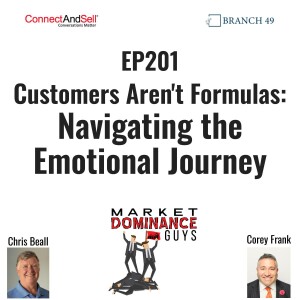
Wednesday Oct 25, 2023
EP201: Customers Aren’t Formulas - Navigating the Emotional Journey
Wednesday Oct 25, 2023
Wednesday Oct 25, 2023
Getting punched in the face is practically a rite of passage for startups with seemingly bulletproof business models. Spreadsheets might predict hockey stick growth, but, as Corey says "customers aren't formulas on a page. They're human beings who are often "repulsed by new technology". Adoption requires an emotional journey and trust, not a formula. Yet founders frequently ignore reality, believing spreadsheets will magically generate growth. Chris says this quest for an easy quota can even derail progress as "salespeople focused on quota may take company backwards" by clinging to the past. Hence leaders must prevent "retrograde motion back to what was comfortable before" by being "hard-edged on changing direction." There are no maps for the uncharted path from startup to sustainable enterprise. But experienced guides like Corey and Chris are happy to share their battle scars and perspectives. Join us for this episode, “Customers Aren't Formulas: Navigating the Emotional Journey.”
Full episode transcript below:
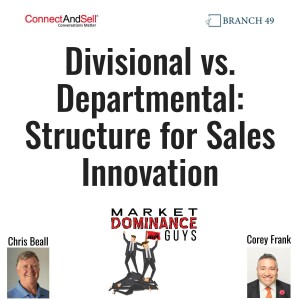
Wednesday Sep 20, 2023
EP197: Divisional vs. Departmental - Structure for Sales Innovation
Wednesday Sep 20, 2023
Wednesday Sep 20, 2023
The guys are back together! Join our master salesmen Corey Frank and Chris Beall as they dive into this discussion on business strategy inspired by a recent event Corey attended featuring Rami Goldratt of the Theory of Constraints Institute. Discussing key concepts like inertia, identifying constraints, and the politics involved, they provide insight for sales managers and CROs looking to break through barriers to growth. Chris explains how constraints manifest on the buyer's side, in their emotions and feelings of possibility. On the execution side, he advocates building key elements in advance to avoid delays. He and Corey cover divisional vs departmental structure, M&A pitfalls, and more insights. Join them for this episode, “Divisional vs. Departmental – Structure for Sales Innovation.”
Full episode transcript below:
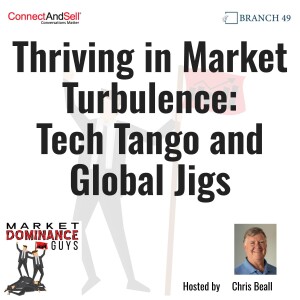
Wednesday Aug 23, 2023
EP193: Thriving in Market Turbulence - Tech Tango and Global Jigs
Wednesday Aug 23, 2023
Wednesday Aug 23, 2023
In this episode, Chris Beall, CEO of ConnectAndSell, discusses various challenges faced by B2B sales leaders in the modern business landscape. With Corey Frank, CEO of Branch49, absent from the co-host chair, Chris invited ChatGPT to take a seat. He starts by introducing the idea of asking ChatGPT about challenges in B2B sales. He touches on the challenge of coaching sales reps, particularly their first failure points in conversations. Chris explains how technology, such as the one developed by Symbl.ai, can help identify these first failure points and support reps in improving their performance.
Chris stresses that addressing these challenges requires a combination of strategic thinking, technological proficiency, people management skills, and deep industry understanding.
Some of the challenges covered include:
Adapting to Technological Change
Understanding Customer Needs
Compliance and Regulation
Maintaining Quality Lead Generation
Managing Sales Team Performance
Pricing Strategies in a Competitive Market
Cultural and Geographical Differences
Integrating Sales with Other Business Functions
Economic Uncertainties
Full episode transcript below:
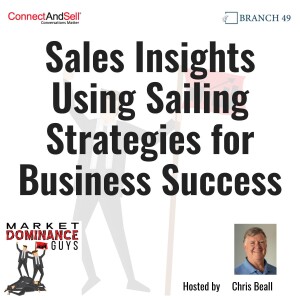
Tuesday Aug 15, 2023
EP192: Sales Insights Using Sailing Strategies for Business Success
Tuesday Aug 15, 2023
Tuesday Aug 15, 2023
Today's adventure is a jaunt on the high seas with Chris Beall's wife, Helen Fanucci, the sailing extraordinaire (before she even became his better half).
Now, my sailing skills are on par with a landlocked pirate. But no matter because this story isn't just about boats and briny waters – it's a tale of drive, insight, and a dash of brilliance that'll leave you pondering your business compass.
Picture it: a sun-soaked day, a boat called J80, and Helen Fanucci – a mechanical maestro with a thirst for precision. Amidst the waves, she spots a teeny metal tab on the mast, having a bit of a tiff with its groove.
But here's the twist – she didn't pounce on the problem like a hungry seagull on a French fry. Oh no! She executed a strategic dance of action and contemplation. Think of it as a chess grandmaster swapping their knight for a piña colada mid-game. The result? A symphony of decisions, a triumphant "click," and a lesson that'll rock your business boat. Join Chris for the full story in this episode, "Sales Insights Using Sailing Strategies for Business Success."
Full episode transcript below:
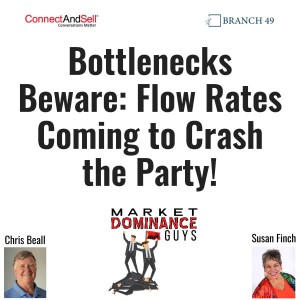
Wednesday Jul 19, 2023
EP188: Bottlenecks Beware: Flow Rates Coming to Crash the Party!
Wednesday Jul 19, 2023
Wednesday Jul 19, 2023
Chris unravels the enchanting world of manufacturing. Gone are the days of painstakingly crafting artifacts one by one, like our Stone Age ancestors. Now, we're immersed in the art of flow manufacturing, where tanks channel the flow of chemicals, and even discreet manufacturing dances to the rhythm of flow. It's a symphony of efficiency where our sales teams manufacture opportunities, creating the invaluable currency of option value.
Chris urges us to view our sales organizations as factories where identifying bottlenecks and maximizing flow rates are the keys to success. In this world, conversion rates become the icing on the cake, but only after we've mastered the flow.
Finally, Chris challenges the age-old debate of quality versus quantity and reminds us that we're left with nothing without quantity. Join us for this episode, "Bottlenecks Beware: Flow Rates Coming to Crash the Party!"
Links from this episode:
Corey Frank on LinkedInChris Beall on LinkedIn
Branch 49ConnectAndSell
Full episode transcript below:
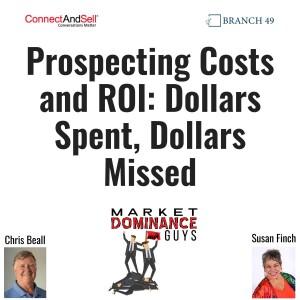
Thursday Jul 13, 2023
EP187: Prospecting Costs - Dollars Spent, Dollars Missed
Thursday Jul 13, 2023
Thursday Jul 13, 2023
The game isn't won with the buzzer shot. The game is won by endless hours of preparing for the buzzer shot. Chris and Susan dive deep into the often-overlooked topic of prospecting costs and return on investment (ROI). Chris's passion for the subject shines through as he challenges conventional thinking and emphasizes the importance of time as the ultimate business denominator. He reveals that traditional efficiency metrics like conversion rates and ratios have little to do with business success. Instead, he argues that prospecting is about maximizing the value of every hour and building a robust pipeline. Chris expertly breaks down prospecting ROI, highlighting the investment in time and the need to attribute pipeline growth back to conversations.
Throughout the episode, they share pro tips and emphasize the need for a strategic and holistic approach to prospecting beyond research and follow-ups. This engaging discussion is a must-listen for sales professionals looking to unlock the true potential of prospecting and boost their ROI. Join Chris and Susan for this episode, "Prospecting Costs and ROI: Dollars Spent, Dollars Missed."
Links from this episode:
Susan Finch on LinkedInChris Beall on LinkedIn
Funnel Media GroupConnectAndSell
Full episode transcript below:
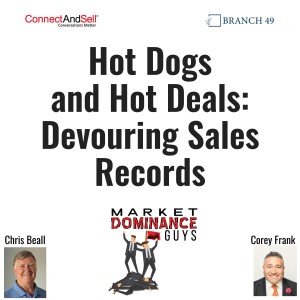
Thursday Jul 06, 2023
EP186: Hot Dogs and Hot Deals - Devouring Sales Records
Thursday Jul 06, 2023
Thursday Jul 06, 2023
Chris and Corey asked me to prepare you for a mind-expanding journey as we take Dr. Goldratt’s theory of constraints beyond its traditional boundaries and revolutionize the way you approach sales. Discover the art of identifying the true constraint and learn why pulling together as a team can sometimes snap the traces. We uncover the secrets of critical paths, buffers, and the profound impact of time in the fast-paced sales arena. Embrace your inner rebel and challenge the norms by seeking fresh perspectives from other disciplines.
But wait, there's more! Get inspired by the legendary story of competitive eater Kobe and his unconventional strategies that shattered records. We'll show you how to think outside the bun and achieve unprecedented sales success. Join us for this episode covering mastering sales success by unleashing the power of constraints and revolutionary strategies but we’ll just call it, “Hot Dogs and Hot Deals: Devouring Sales Records!"
Links from this episode:
Corey Frank on LinkedInChris Beall on LinkedIn
Branch 49ConnectAndSell
Full episode transcript below:
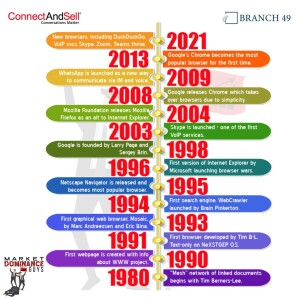
Wednesday Mar 29, 2023
EP175: How ChatGPT Can Improve Sales Enablement
Wednesday Mar 29, 2023
Wednesday Mar 29, 2023
In this episode of the Market Dominance Guys podcast, Chris, Corey and Helen Fanucci discuss the evolution of the internet, from its early days as a way for messages to move across networks to the democratization of global information through the browser and search engines. They also explore the capabilities of ChatGPT, including its ability to generate email responses and interact with customers using personalized prompts. They highlight the potential of ChatGPT to save time and improve the quality of communication for sales professionals. Join us for this idea-filled episode, "How ChatGPT Can Improve Sales Enablement."
Four ideas on how sales professionals can benefit from using ChatGPT for follow-up:
Personalized Follow-Up: ChatGPT can help sales professionals create personalized follow-up messages for each customer based on their preferences, interests, and past interactions with the sales team. ChatGPT can analyze the customer's conversation history and provide personalized responses that feel like a human wrote them.
Lead Nurturing: ChatGPT can help sales professionals nurture leads by sending automated follow-up messages to potential customers at regular intervals. These messages can be customized to meet the specific needs of each customer, making it easier to keep them engaged with the sales process.
Schedule Meetings: ChatGPT can help sales professionals schedule meetings with potential customers by automating the process of finding a mutually convenient time to meet. This can save the sales team a lot of time and effort by eliminating the need to go back and forth with customers trying to find a suitable time.
Provide Instant Customer Support: ChatGPT can be used to provide instant customer support to customers who have questions or concerns about a product or service. Sales professionals can use ChatGPT to respond to these inquiries in real-time, providing customers with the information they need to make a purchasing decision. This can help increase customer satisfaction and improve the chances of closing a sale.
The Evolution of the Internet and Digital Communications
1960s: The concept of hypertext is introduced by Ted Nelson.
1980: Tim Berners-Lee develops the idea of a "mesh" network of hyperlinked documents and begins working on the WorldWideWeb (WWW) project.
1990: The first web page is created by Tim Berners-Lee. It contains information about the WWW project and how to use a web browser.
1991: The first web browser, called WorldWideWeb, is developed by Tim Berners-Lee. It was a text-only browser and was only available on the NeXTSTEP operating system.
1993: The first graphical web browser, called Mosaic, is released by Marc Andreessen and Eric Bina. It was a huge success and helped to popularize the web.
1994: The first search engine, called WebCrawler, is launched by Brian Pinkerton. It was the first search engine to index entire web pages rather than just titles and headings.
1995: Netscape Navigator is released by Netscape Communications Corporation. It becomes the most popular web browser and sets the standard for web browsing features.
1996: The first version of Internet Explorer is released by Microsoft, marking the beginning of the "browser wars" between Microsoft and Netscape.
1998: Google is founded by Larry Page and Sergey Brin. Their search engine quickly becomes the most popular and sets a new standard for search technology.
2003: Skype is launched, becoming one of the first and most popular VoIP (Voice over Internet Protocol) services.
2004: Mozilla Firefox is released by the Mozilla Foundation as an open-source alternative to Internet Explorer.
2008: Google releases the first version of the Chrome browser, which quickly becomes popular due to its speed and simplicity.
2009: WhatsApp is launched, providing a new way for people to communicate via instant messaging and voice calls over the internet.
2010: Microsoft releases Internet Explorer 9, which is considered a major improvement over previous versions.
2013: Google's Chrome becomes the most popular web browser, surpassing Internet Explorer for the first time.
2021: The current versions of popular web browsers include Google Chrome, Mozilla Firefox, Apple Safari, Microsoft Edge, and Opera. Popular search engines include Google, Bing, Yahoo, and DuckDuckGo. VOIP services like Skype, Zoom, and Teams have become critical tools for remote communication in response to the COVID-19 pandemic. The Worldwide Web continues to evolve and expand, with new technologies and innovations being introduced regularly.
2022: ChatGPT from OpenAI.com takes the world by storm and changes how we write and communicate forever.
Full episode transcript below:
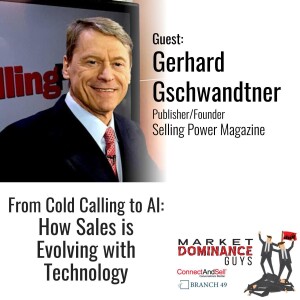
Wednesday Mar 01, 2023
EP171: From Cold Calling to AI: How Sales is Evolving with Technology
Wednesday Mar 01, 2023
Wednesday Mar 01, 2023
In this episode, Gerhard Gschwandtner compares ChatGPT to a painter's palette with an infinite amount of colors, and salespeople are the artists who must decide how many colors to use and when the painting is finished. The hosts discuss the role of technology in sales and how salespeople can use ChatGPT to harness its intelligence to make more informed decisions. Chris describes a practical example of how he used ChatGPT for list creation for a company called Partner Tap. He was able to ask it about the specific job titles used in senior roles in companies and generate a table of titles for each company. Gerhard suggests that salespeople can tap into their internal ChatGPT to discover great ideas and pursue meaningful work. Chris mentions how they are exploring the use of ChatGPT in developing a new data product and using it to summarize the best conversations that set a meeting with different types of executives. Key points from this portion of the episode include the power of ChatGPT in harnessing technology to make more informed decisions in sales, the importance of pursuing meaningful work, and the potential for ChatGPT to be used in various aspects of sales, from list creation to conversation summaries. Corey reminds us, "You have to be willing to put in that work, do your research and know that it's going to take time. It's not going to happen overnight. It's really about understanding who your customer is and what they care about."
Key points from this episode:
ChatGPT can be used in various aspects of sales, such as list creation and conversation summaries.
Salespeople can use ChatGPT to harness its intelligence and make more informed decisions.
Pursuing meaningful work can lead to greater happiness and success in sales.
The better the "why" behind what you are doing in sales, the easier the "how" will be.
Prompt engineering is a method for developing ChatGPT responses that require careful consideration of the language and wording used in prompts.

Wednesday Feb 15, 2023
EP169: How ChatGPT is Writing a Book: The AI and Human Collaboration
Wednesday Feb 15, 2023
Wednesday Feb 15, 2023
In this episode of Market Dominance Guys, Chris Beall, and Susan Finch discuss their experience using ChatGPT to write a book based on their podcast, and the benefits of using AI to create content. They delve into the limitless possibilities of machine learning, natural language processing, and computer vision, and how they are transforming various industries. Chris and Susan also share their insights on the process and the excitement of seeing the AI learn and improve. Chris and Susan talk about how ChatGPT can generate various versions of a prompt, and the different approaches they took to refine their requests for better results. They also reflect on the human-like interactions they had with ChatGPT, and the Eliza effect that makes people treat the AI as if it were a person. Ultimately, they highlight the efficiency and creativity that AI can bring to content creation, and the potential for using ChatGPT to write more books in the future. Tune in to hear their fascinating discussion on the intersection of AI and writing in this episode, "How ChatGPT is Writing a Book: The AI and Human Collaboration."
Full episode transcript below:
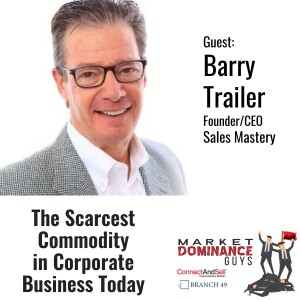
Wednesday Jan 18, 2023
EP165: The Scarcest Commodity in Corporate Business Today
Wednesday Jan 18, 2023
Wednesday Jan 18, 2023
Revealing the scarcest commodity in corporate business, especially in America today, first requires an understanding of how we got there. Today Barry Trailer, Co-founder of Sales Mastery, joins Chris and Corey. He reviews the four levels of process implementation: the percentage of revenue, the target revenue plan attained, the percentage of reps meeting or beating quota, the outcome of forecast deals, and rep turnover. These are real numbers. But higher levels of relationship and higher levels of process implementation lead to higher levels of performance. And the numbers are just the numbers They continued talking about the turnover. There's a huge contributory factor to the failure to implement significant change on the part of most sales organizations other than the change that a new leader brings in.
What is common is that the new lion, so to speak, the new CRO, the new VP of Sales, comes in and kills the cubs. They attempt to prove that whatever was being done before must not be done anymore. Because I've come in with my new way of doing things and territory must be marked, I was brought in to do something in a new way, and away we go. When the performance isn't there, the CRO or the CSO takes the bullet that the CEO doesn't want to take. But the only reason is that there's been this unholy alliance or this unspoken agreement that as long as we make the numbers, you'll stay out of my sandbox. Listen to this episode to see where your company falls in place in, “The Scarcest Commodity in Corporate Business Today.”
Full episode transcript below:
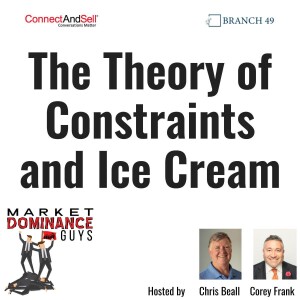
Wednesday Jan 04, 2023
EP163: The Theory of Constraints and Ice Cream
Wednesday Jan 04, 2023
Wednesday Jan 04, 2023
We've heard the phrase, "Be careful what you wish for..." It's not unlike wanting to build pipeline quickly and how it relates to a kid in an ice cream store. What is the goal? Build as much - eat as much as possible to gain as much success and pleasure as possible. Think of the system of building pipeline like a child who isn't sufficiently mature enough to handle all that ice cream. Belly aches will ensue. So the issue with too much too fast is you can't find the bottleneck anymore. And if you can't find the bottleneck anymore, you can't manage.
In this episode, Corey asked Chris to visit the theory of constraints. Businesses are artificial, in the sense, that we say we're going to do something for others, and they're going to pay us money for it. And then the question is, what are the inputs to the business? And whenever you have a system with inputs and outputs, you always have exactly one constraint within that system. That's what the theory of constraints says.
The reason that people like Mark Cuban, Steve Jobs, and Elon Musks, and the like are such outstanding business leaders is they put their eye on the bottleneck regardless of the noise that's produced by the change that they are willing to induce in order to improve. Most of us can't do that. Listen to this episode of Market Dominance Guys, "The Theory of Constraints and Ice Cream."
Full episode transcript below:
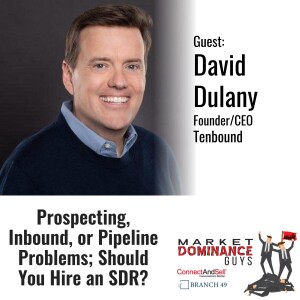
Thursday Dec 15, 2022
EP160: Prospecting, Inbound, or Pipeline Problems; Should You Hire an SDR?
Thursday Dec 15, 2022
Thursday Dec 15, 2022
How are you tracking your pipeline’s success? If you are only looking at one quarter or two, you are missing the larger picture of the attribution. Most of the results are going to be 3, 4, 5, and 6 quarters later. Is it the SDRs, advertising, phone calls made, or conversations you’ve had? If you wait too long to look at where the pipeline is coming from and where it is weak, you may be behind by an additional three to six months at that point. Companies are cutting back on prospecting teams without fully appreciating the long-term effect on the pipeline. David Dulany, Founder and CEO at TenBound, joins Chris and Corey for the first in a three-part series on Market Dominance Guys. In this episode, you’ll hear why a vendor is like someone with one leg of a giraffe and the other of an octopus tentacle. How do you walk with those? Or is it like Wile E Coyote running into the tunnel the Roadrunner painted on the side of the road? Chris sums up this episode, “Failure to prospect today will turn future good times into bad times that are worse than today.” How will you avoid this position? Listen to “Prospecting, Inbound, or Pipeline Problems; Should You Hire an SDR?” to find out.